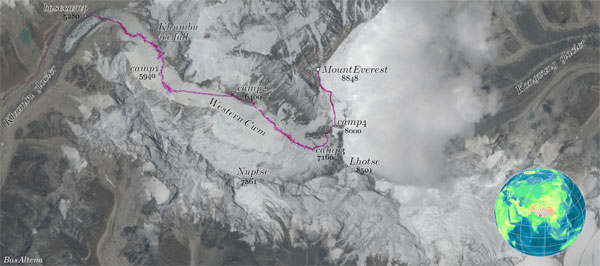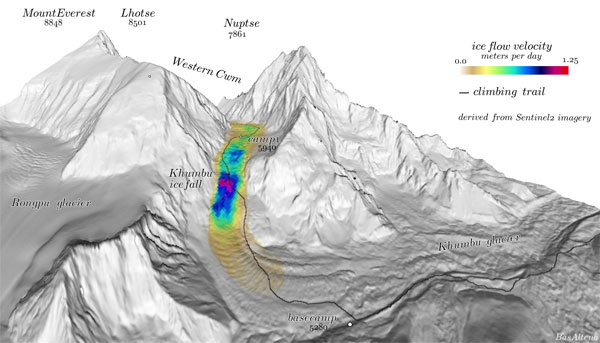Researchers from the University of Oslo have applied a technique to extract the detailed flow field of Khumbu icefall in the Nepalese mountains, from a large collection of Copernicus Sentinel-2 data—thus enhancing the capabilities of these data towards a reliable and consistent glacier mapping instrument.
Researchers from the University of Oslo have applied a technique to extract the detailed flow field of Khumbu icefall in the Nepalese mountains, from a large collection of Copernicus Sentinel-2 data—thus enhancing the capabilities of these data towards a reliable and consistent glacier mapping instrument.
When high altitude mountaineers want to climb Mount Everest from the Nepalese side, they follow a route over and along Khumbu glacier, which at lower elevations is covered with debris. Around Everest basecamp, the glacier of Khumbu starts to receive clean, blueish ice that stems from snow and ice from Western Cwm, the highest glacier in the world.
However, this ice reaches basecamp by transport through Khumbu icefall. This is a part of the glacier that runs over a steep cliff, and like a river undergoes chaotic and fast flow as it moves downwards. It is this section that climbers need to go through, in order to reach the summit of Mount Everest.
Khumbu icefall involves a climb of nearly one thousand metres in elevation gain, mostly through a landscape full of crevasses, large pillars and ice walls. Luckily, a path is created through this turbulent environment by trained Nepali workers, called ice doctors.
Every year before the climbing season starts, they explore routes and lay ropes along them, placing aluminium ladders over the crevasses. The icefall is constantly moving, so throughout the climbing season crevasses will open and close. Consequently, the team of ice doctors stay in Everest basecamp to be able to maintain the route through the icefall and re-secure ladders and ropes.
Crevasses on a glacier originate when a certain shear strength is reached (when there is a difference in velocity). Thus, in general, the faster ice flow in the middle of a glacier will generate crevasses on its sides, but when the flow over the whole glacier surface is known, these regions can be mapped accordingly.
The velocity pattern can thus be used to map dangerous areas on a glacier. Use of satellites for this purpose is evident, as these regions are very dangerous to access. Fortunately, it is possible to observe glacier flow from space. But over the fast moving icefall of Khumbu glacier this had not been possible yet, because the glacier ice funnels through a narrow corridor of rock, causing disorderly fracture ice to flow downward and making feature tracking difficult.
Thanks to a large collection of data from the Sentinel-2 satellites of the European Union's Copernicus Programme, the researchers extracted the detailed flow field of Khumbu icefall.
Launched on 23 June 2015 and followed by its twin on 7 March 2017, the mission provides detailed information about Earth's land and coastal waters. Copernicus Sentinel-2 multispectral optical imagery at high spatial resolution supports a large range of applications such as precision farming, forestry management, water quality monitoring, and natural disasters management.
The researchers exploited the high temporal revisit of high-resolution satellite images using a novel image matching technique, ensemble matching, making it possible to generate a high-resolution (30 m) velocity field from high-repeat image sequences despite challenging image conditions.
Bas Altena, lead author of the study and researcher at University of Oslo found this specific application, and emphasised, "We used multiple optical imagery altogether, taking advantage of the high repeat rate of Copernicus Sentinel-2. This mission with two satellites in orbit can already generate detailed time-series of glacier velocity for large glaciers, but for smaller and fast flowing sections the current algorithms are challenged.
"Our approach can provide solutions to these demanding situations, enhancing the capabilities of Copernicus Sentinel-2 towards a reliable and consistent glacier mapping instrument, with operational performance. We hope that our results, be it little, can be of help to the ice doctors for managing the route through the icefall," concluded Dr Altena.
About the Copernicus Sentinels
The Copernicus Sentinels are a fleet of dedicated EU-owned satellites, designed to deliver the wealth of data and imagery that are central to the European Union's Copernicus environmental programme.
The European Commission leads and coordinates this programme, to improve the management of the environment, safeguarding lives every day. ESA is in charge of the space component, responsible for developing the family of Copernicus Sentinel satellites on behalf of the European Union and ensuring the flow of data for the Copernicus services, while the operations of the Copernicus Sentinels have been entrusted to ESA and EUMETSAT.
Read more at:
Altena, B. & Kääb, A. (2020). Ensemble matching of repeat satellite images applied to measure fast-changing ice flow, verified with mountain climber trajectories on Khumbu icefall, Mount Everest. Journal of Glaciology. https://doi.org/10.1017/jog.2020.66


